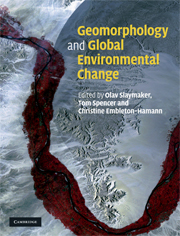Book contents
- Frontmatter
- Contents
- List of contributors
- Preface
- Acknowledgements
- List of acronyms and abbreviations
- 1 Landscape and landscape-scale processes as the unfilled niche in the global environmental change debate: an introduction
- 2 Mountains
- 3 Lakes and lake catchments
- 4 Rivers
- 5 Estuaries, coastal marshes, tidal flats and coastal dunes
- 6 Beaches, cliffs and deltas
- 7 Coral reefs
- 8 Tropical rainforests
- 9 Tropical savannas
- 10 Deserts
- 11 Mediterranean landscapes
- 12 Temperate forests and rangelands
- 13 Tundra and permafrost-dominated taiga
- 14 Ice sheets and ice caps
- 15 Landscape, landscape-scale processes and global environmental change: synthesis and new agendas for the twenty-first century
- Index
14 - Ice sheets and ice caps
Published online by Cambridge University Press: 05 July 2015
- Frontmatter
- Contents
- List of contributors
- Preface
- Acknowledgements
- List of acronyms and abbreviations
- 1 Landscape and landscape-scale processes as the unfilled niche in the global environmental change debate: an introduction
- 2 Mountains
- 3 Lakes and lake catchments
- 4 Rivers
- 5 Estuaries, coastal marshes, tidal flats and coastal dunes
- 6 Beaches, cliffs and deltas
- 7 Coral reefs
- 8 Tropical rainforests
- 9 Tropical savannas
- 10 Deserts
- 11 Mediterranean landscapes
- 12 Temperate forests and rangelands
- 13 Tundra and permafrost-dominated taiga
- 14 Ice sheets and ice caps
- 15 Landscape, landscape-scale processes and global environmental change: synthesis and new agendas for the twenty-first century
- Index
Summary
Introduction
Astronauts who first orbited the Earth in the Space Shuttle described the Antarctic Ice Sheet as the most spectacular of the world's landscapes seen from space. The sight of the white snow surface, the surrounding Southern Ocean, and the sheer extent of the ice covering a continent one and a half times the size of the USA was dramatic and humbling (Fig. 14.1; Plate 45). The global scene would have been all the more dramatic about 20 ka BP at the height of the last ice age. An orbiting observer at the time would have seen the Laurentide Ice Sheet, an equally large ice mass located over Canada and the northern USA, a Greenland Ice Sheet more expanded than that of today, and a large ice sheet in northwest Europe extending from southern Britain across Scandinavia to Svalbard and northern Russia. At such a time global sea level was 120m lower than it is today and the world's climatic and vegetation zones were compressed towards the equator (Plate 1). The contrast between the two scenes is powerful testament to the scale of the environmental changes that occur in response to natural cycles of insolation received by the Earth.
Ice sheets play a fundamental role in modulating global climate. The last few ice age cycles have lasted about 100 ka and display a sawtooth pattern with a long and irregular period of cooling as the ice sheets grow to their maximum, followed by an abrupt warming and a return to an interglacial climate similar to that of the present. Such a pattern is of a world hunting for a cooler equilibrium state only to cross a threshold which switches back to its warmer state, only for the cycle to repeat itself again. At present we do not know the feedbacks and links that explain this pattern, but the ice sheets are likely to be involved in amplifying the relatively minor changes in solar radiation received by the Earth as a result of Croll–Milankovitch orbital cycles.
- Type
- Chapter
- Information
- Geomorphology and Global Environmental Change , pp. 368 - 402Publisher: Cambridge University PressPrint publication year: 2009
- 1
- Cited by



